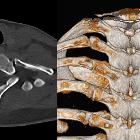kostovertebrale Dysostose
Spondylocostal dysostosis (SCDO) is a rare condition characterized by short-trunk dwarfism secondary to developmental anomalies of the vertebrae and ribs. Previously the condition Jarcho-Levin syndrome (also known as spondylothoracic dysostosis) was grouped together with spondylocostal dysostosis, but the two diseases are now considered to be distinct entities.
Epidemiology
A rare condition, almost 400 cases of spondylocostal dysostosis have been described in the literature .
Clinical presentation
Spondylocostal dysostosis is characterized by a short-trunk dwarfism phenotype (normal length upper and lower limbs with a disproportionately-reduced size central body and short neck) due to maldevelopment of the vertebrae and ribs. A mild kyphoscoliosis is often present.
The abnormal development of the ribs including absent (rarely increased number), malalignment and/or fused ribs, such that overall there is a constricted thorax (narrow fetal thorax) leading to breathing difficulties, which can be life-threatening. Due to a lack of room in which to inflate, the lungs expand inferiorly, pushing down on the abdominal viscera resulting in secondary herniation, including umbilical, diaphragmatic, and inguinal hernias.
Vertebral anomalies occur at all levels of the spine, including:
- butterfly vertebrae
- hemivertebrae
- fused vertebrae
- hypoplastic vertebrae
Associated abnormalities include cardiac and genitourinary anomalies, and occasionally neural tube defects (including spinal dysraphism and Chiari malformation).
Pathology
Genetics
Primarily the disease is autosomal recessive, although rarer autosomal dominant forms have been described. Mutations have been found in genes coding for proteins from the Notch signaling pathway. This pathway is important in the process of somite segmentation, central to the development of the vertebrae and ribs. Mutations in the genes DLL3, MESP2, LFNG, and HES7, account for the respective clinicoradiological types 1-4 i.e. SCDO1 to SCDO4.
Treatment and prognosis
The small size of the thorax in newborns frequently leads to respiratory compromise and death in infancy. Some rare variants with survival into adulthood have also been described.
History and Etymology
Saul Jarcho and Paul Levin first described the condition at Johns Hopkins in 1938 . The condition that they described most closely resembles SCDO2 although Jarcho-Levin syndrome is now usually reserved for cases of spondylothoracic dysotosis .
Siehe auch:
- Spina bifida
- Schmetterlingswirbel
- angeborene Wirbelanomalien
- fetal ventriculomegaly
- Myeloschisis
- Halbwirbel
- ventriculomegaly
- Jarcho-Levin-Syndrom
- narrow fetal thorax
- costovertebrale Dysplasie
und weiter:

 Assoziationen und Differentialdiagnosen zu kostovertebrale Dysostose:
Assoziationen und Differentialdiagnosen zu kostovertebrale Dysostose:






